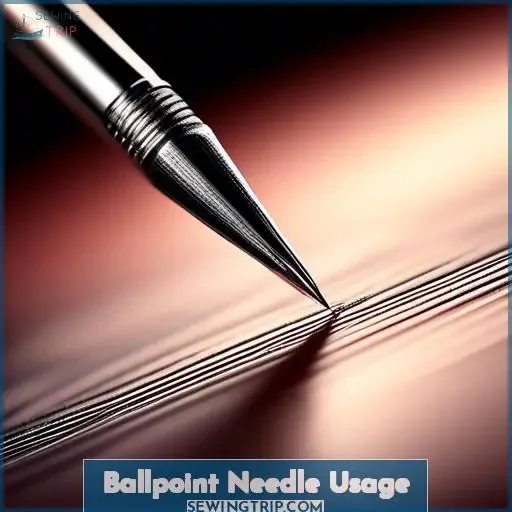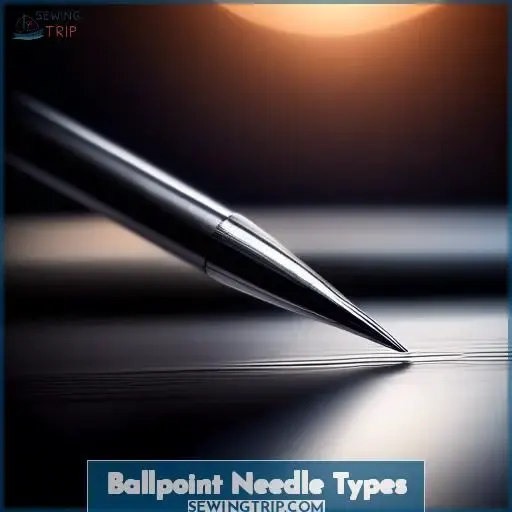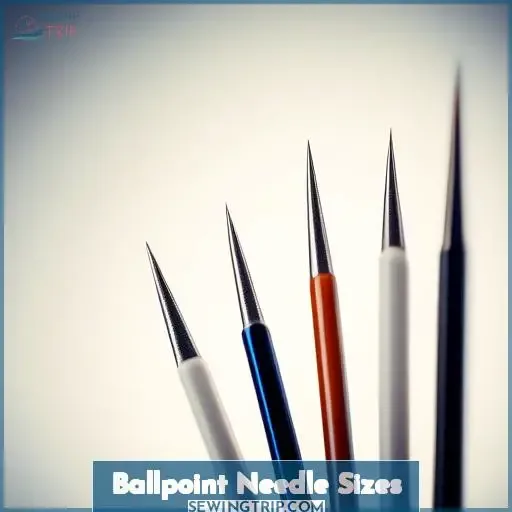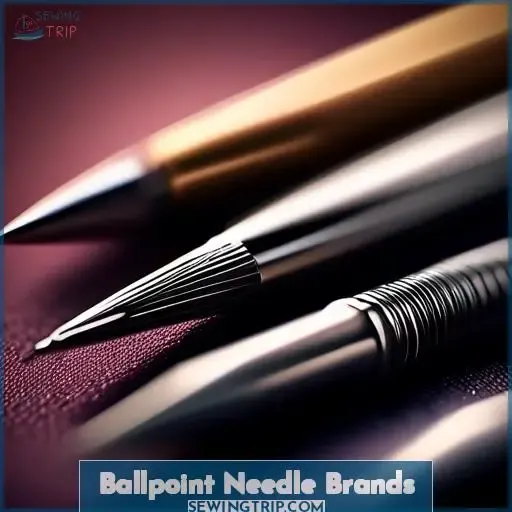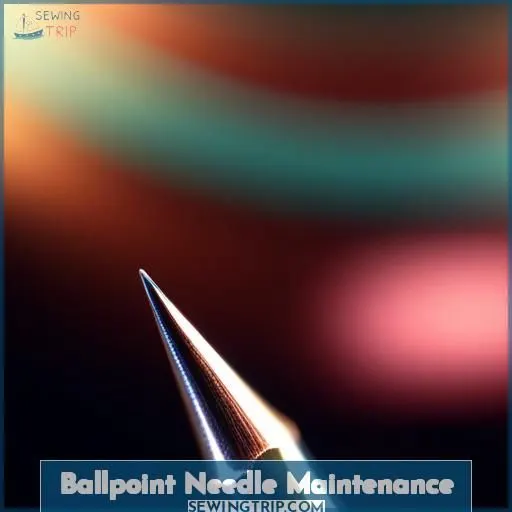This site is supported by our readers. We may earn a commission, at no cost to you, if you purchase through links.
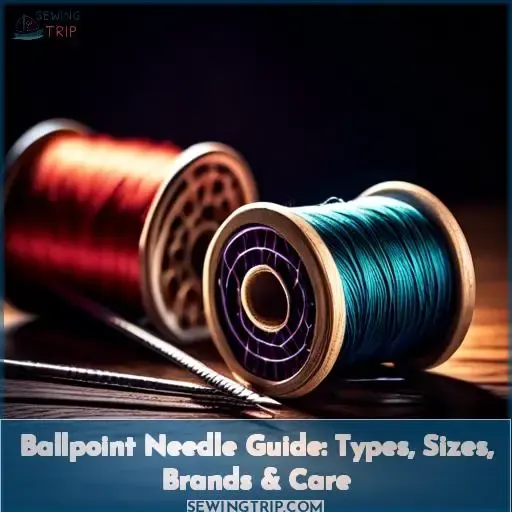
Table Of Contents
Key Takeaways
- Ballpoint needles are designed for knit fabrics and have a rounded tip that separates fibers instead of piercing them, preventing stretching or ripping.
- They are suitable for most knit fabrics, except for very fine or tightly woven ones, such as microfiber or spandex, and not ideal for very thick or stiff threads, such as cotton or polyester.
- To get the best results when using a ballpoint needle, it’s essential to choose the appropriate size for the fabric and thread being used, with standard sizes ranging from 70/10 to 100/16.
- Ballpoint needles can be used for both hand and machine sewing and are ideal for sewing with knits and some stretch fabrics, preventing skipped stitches and creating smooth, professional-looking seams.
What is a Ballpoint Needle Used For?
A ballpoint needle is used for sewing knit fabrics as it slips between fibers without causing damage, making it ideal for stretchy materials.
Ballpoint Needle Usage
Using a ballpoint needle makes sewing with stretch fabrics easier and more efficient. These needles are specifically designed for knit fabrics and have a rounded tip that separates fibers instead of piercing them, preventing stretching or ripping. Ballpoint needles are suitable for most knit fabrics, except for very fine or tightly woven ones, such as microfiber or spandex. They’re also not ideal for very thick or stiff threads, such as cotton or polyester.
To get the best results when using a ballpoint needle, it’s essential to choose the appropriate size for the fabric and thread being used. Standard sizes range from 70/10 to 100/16, with size 70/10 being the smallest and 100/16 the largest. It’s also crucial to change needles after every 6-8 hours of sewing, depending on the type of stitching and usage. Dull or damaged needles can cause fabric damage, so it’s important to maintain your needles properly.
Ballpoint needles can be used for both hand and machine sewing and are ideal for sewing with knits and some stretch fabrics. They prevent skipped stitches and create smooth, professional-looking seams. When storing needles, it’s essential to keep them in a safe and dry place and away from children.
Ballpoint needles are available at local fabric, craft, and quilt shops, as well as online. It’s advisable to purchase a variety of sizes for different fabrics and keep a supply of needles on hand for quick replacements. When shopping for ballpoint needles, consider reputable brands and suppliers to ensure quality and durability.
Ballpoint Needle Types
When it comes to sewing with knits and some stretch fabrics, ballpoint needles are your go-to choice. These needles have a rounded tip that separates fibers instead of piercing them, preventing stretching or ripping. They’re ideal for sewing with knits and some stretch fabrics, but not suitable for woven fabrics. Ballpoint needles come in various types, each designed for specific fabrics and stitching techniques.
For heavier, looser sweater knits, ballpoint needles with a larger eye and a flat shank are recommended. These needles aren’t tapered and are designed to prevent cutting threads. For highly elastic fabrics, stretch needles are preferred. They’ve a larger eye and are designed to accommodate thicker threads, making them perfect for sewing with spandex and other stretchy materials.
Ballpoint needles come in different sizes, with the standard size range being 70/10, 80/12, 90/14, and 100/16. The size you choose depends on the fabric and thread you’re using. Size 70/10 is the smallest and 100/16 is the largest. It’s essential to choose the appropriate size for your sewing project to ensure smooth, professional-looking seams.
Ballpoint needles are available at local fabric, craft, and quilt shops, as well as online. When purchasing ballpoint needles, consider reputable brands and suppliers to ensure quality and durability. It’s advisable to keep a supply of needles on hand for quick replacements, as they should be changed after every 6-8 hours of sewing to prevent fabric damage. Dull or damaged needles can cause skipped stitches and fabric damage.
In conclusion, ballpoint needles are a versatile and essential tool for sewing with knits and some stretch fabrics. Understanding the different types, sizes, and brands of ballpoint needles can help you navigate the complexities of the sewing world and unlock the secrets to creating smooth, professional-looking seams.
Ballpoint Needle Sizes
Ballpoint needle sizes are crucial for ensuring a seamless sewing experience. These needles, designed for closely woven fabrics, come in various sizes to cater to different fabric weights and stitching types.
- Different Fabrics, Different Sizes: Ballpoint needles are available in different sizes to accommodate various fabric weights. For example, lighter fabrics may require a smaller needle size, while heavier fabrics may need a larger one.
- Choosing the Right Size: The appropriate needle size depends on the fabric and thread being used. A general rule of thumb is to match the needle size to the thread size. However, it’s essential to consider the fabric type as well.
- Needle Maintenance: Regularly changing needles is crucial for maintaining the quality of your stitching. Dull or damaged needles can cause fabric damage and lead to skipped stitches. It’s recommended to change needles after every 6-8 hours of sewing, but the frequency may vary depending on the stitching type and usage.
- Availability: Ballpoint needles are widely available at local fabric, craft, and quilt shops, as well as online. It’s advisable to purchase a variety of sizes to ensure you have the right needle for each fabric type.
In conclusion, understanding ballpoint needle sizes is essential for achieving successful sewing results. By choosing the right needle size for your fabric and thread, you can prevent fabric damage, create smooth seams, and enjoy a more efficient sewing experience.
Ballpoint Needle Brands
When it comes to ballpoint needles, there are several reputable brands that offer high-quality products. These brands include Singer, Schmetz, Inspira, and Organ, which are known for their durability and compatibility with various sewing machines. Singer, in particular, offers a range of ballpoint needles designed to prevent skipped stitches and runs in knit fabrics. Schmetz is another popular brand that provides a variety of ballpoint needles in different sizes and quantities, ensuring you have the right needle for your project.
When it comes to availability, ballpoint needles can be found at local fabric and quilt shops, as well as online retailers like Amazon. It’s advisable to check for reputable brands and suppliers to ensure you’re getting a high-quality product. Additionally, consider purchasing a variety of sizes for different fabrics to have on hand for quick replacements.
In terms of needle longevity, it’s essential to change needles after every 6-8 hours of sewing to prevent fabric damage and ensure smooth, professional-looking seams. Dull or damaged needles can cause skipped stitches and fabric puckering, which can be frustrating and time-consuming to fix.
Ballpoint needles are designed to alleviate making holes in knit or loosely woven materials by slipping between yarns rather than piercing them. This makes them ideal for sewing with knits and some stretch fabrics. However, they aren’t suitable for woven fabrics.
In summary, when choosing a ballpoint needle brand, consider the needle’s compatibility with your sewing machine, its longevity, and the availability of different sizes for various fabrics. Brands like Singer, Schmetz, Inspira, and Organ offer high-quality ballpoint needles that can be found at local fabric and quilt shops and online retailers. Remember to change needles regularly to maintain the best possible sewing experience.
Ballpoint Needle Maintenance
To ensure your ballpoint needles last as long as possible, it’s crucial to maintain them properly. Here are some tips on ballpoint needle storage, cleaning, disposal, sharpening, and lubrication.
Ballpoint Needle Storage:
- Keep needles in a safe, dry place, away from children.
- Store needles in a case or box to prevent damage.
- Avoid storing needles in direct sunlight or extreme temperatures.
Ballpoint Needle Cleaning:
- Clean needles after every sewing session to prevent thread build-up.
- Use a soft-bristled brush or cloth to gently remove thread.
- Avoid soaking needles in water, as this can damage the needle.
Ballpoint Needle Disposal:
- Dispose of dull or damaged needles properly.
- Don’t throw needles in the trash, as they can pose a safety hazard.
- Check with your local recycling program for proper disposal options.
Ballpoint Needle Sharpening:
- Sharpen needles regularly to maintain their effectiveness.
- Use a needle sharpener designed for ballpoint needles.
- Be careful not to over-sharpen, as this can damage the needle.
Ballpoint Needle Lubrication:
- Lubricate needles with a needle oil or beeswax to prevent friction.
- Apply lubricant to the needle eye and shaft.
- Avoid using oil on the needle tip, as this can attract dirt and dust.
Troubleshooting Tips:
- If your needle is skipping stitches, it may be dull or damaged.
- If your needle isn’t sewing smoothly, it may need lubrication.
- If your needle is breaking frequently, it may be too sharp or the wrong size.
Change Needles:
- Change needles after every 6-8 hours of sewing, or when the needle becomes dull.
- Choose the appropriate size needle for the fabric and thread being used.
- Keep a supply of needles on hand for quick replacements.
By following these maintenance tips, you can ensure your ballpoint needles last as long as possible and sew smoothly. Remember, a well-maintained needle is a sewer’s best friend.
Frequently Asked Questions (FAQs)
Can ballpoint needles be used for embroidery?
Ballpoint needles are used for knit fabrics and loosely woven materials, as they’re designed to alleviate making holes in these types of fabrics. They’re commonly used for machine embroidery on knits and can be found in various needle eye sizes to best fit the embroidery.
How do ballpoint needles affect stitch quality?
Ballpoint needles are designed for sewing with knitted fabrics. They’ve a rounded tip that pushes the fibers aside, rather than piercing them, which prevents stretching or ripping of the fabric. This makes them ideal for sewing with knits and some stretch fabrics, as they prevent skipped stitches and create smooth, professional-looking seams.
Are ballpoint needles suitable for leather projects?
Ballpoint needles are suitable for leather projects. They have a rounded tip that slips between yarns rather than cutting them, preventing broken fibers and the attendant unraveling.
This makes them ideal for sewing on knit type fabrics, including leather, as they don’t make holes in the material. However, it’s essential to use a needle designed specifically for leather, as standard ballpoint needles may not be suitable for all types of leather projects.
What’s the difference between ballpoint and stretch needles?
Ballpoint needles are designed specifically for knit fabrics, such as sweaters, and are suitable for most knit fabrics, except for very fine or tightly woven ones, like microfiber or spandex. They have a more rounded tip than universal needles, which allows them to slide between the loops of the knit fabric without piercing or breaking them, reducing the risk of skipped stitches, puckered seams, or damaged fabric.
Stretch needles, on the other hand, are a special type of ballpoint needles that are made for very stretchy or elastic knit fabrics, such as spandex, lycra, or fleece. They have a longer eye and a deeper scarf than ballpoint needles, which allows for a longer thread loop to form, increasing the chance that it will be caught by the hook of the sewing machine, preventing thread breakage when the fabric is stretched.
Can I use a ballpoint needle on quilts?
You shouldn’t use a ballpoint needle for quilting; it’s like bringing a basketball to a football game. Stick to sharp or quilting needles to avoid puckering and get those crisp, straight stitches.
Conclusion
As you delve into the world of ballpoint needles, you’ll find a vast array of options designed to enhance your sewing experience.
From various types and sizes to top-tier brands, each needle is meticulously crafted to meet your specific needs.
By understanding the complexities of this realm, you can navigate towards a bespoke and tailored approach to your sewing projects.

